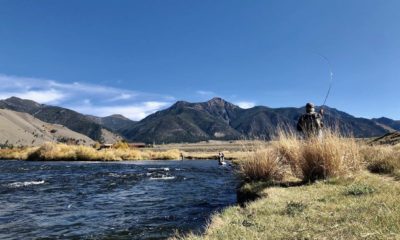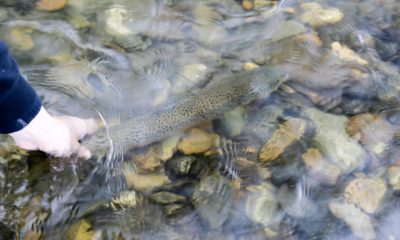Uncategorized
Nymphing: fly fishing’s misunderstood art
Published
9 years agoon


By Patrick Straub
Explore Big Sky Fishing Columnist
This might sound like the beginning to Norman Maclean’s treatise in “A River Runs Through It and Other Stories,” but in my family there was no clear line between work and outdoor recreation. I grew up in the foothills south of Bozeman where I fished with my brothers and watched my parents help others enjoy the outdoors – my mom as a career ski instructor and my father as a camp manger in Paradise Valley. Summers were spent bloodying shins on the rocks of small creeks and winters picking lines off Bridger Bowl’s ridge.
I learned to fish dry flies at a young age and when the fish would not eat a Coachman Trude or a Royal Wulff, I would occasionally throw a woolly bugger. It wasn’t until college when I finally understood and appreciated the subtleties of fishing flies sub-surface. This progression is not unique to my angling background, as many of us started with single dry flies and have progressed to long leaders with strike indicators, split-shot, and two-weighted flies on fluorocarbon tippets.
Why did things get so complicated? Because we like to catch fish, that’s why. It took me a while to successfully fish nymphs. Few things in angling top watching a fish eat your dry fly on the surface, but the more you can successfully fish flies under the surface, the more fish you’ll catch. Here’s some help that I never had.
Look at the big picture. Fishing nymphs requires an in-depth – pun-intended – look into the angling scene. When fishing dry flies you’re often focused only on the surface. Nymphing adds the elements of current speed, underwater structure and depth to the equation. You must determine the proper amount of weight on your leader, fly size, getting a proper drift, detecting the strike, and setting the hook. Not easy things to accomplish all at once, but by observing and imagining what is happening under the water’s surface, you’ll be in the right mindset.
Rock bottom. Nymphing is the down-and-dirty way to catch fish. Most fish spend the bulk of their life near the bottom of the river and a nymph floating by is easy to eat. Fish on the bottom also exert a lot less energy than fish near the surface, so if you can get your fly down to them you’re going to catch more.
Fish fluorocarbon leaders and tippets. For more than 20 years now, fluorocarbon has been responsible for landing a lot more fish because its chemical structure makes it sink. With this material you can also fish a heavier breaking-strength line than with conventional monofilament. For example, you can fish a 4X fluorocarbon instead of 3X monofilament and have similar strength yet thinner diameter, which helps attain a better drift. Also, some argue that fluorocarbon is invisible under the surface. I’m not totally sold on this, but I can say from experience that when fishing subsurface, fluorocarbon out-fishes conventional mono.
Weight and good things will come. Having some weight – split shot or moldable putty for example – on your leader will help sink the flies to the proper depth. I don’t like to use weight if I don’t have to, but in my kit bag I have three assortments of various sizes of split shot. It’s annoying as heck, but it helps me consistently catch fish whether I’m nymphing out of my boat on the Missouri, sight fishing on DePuy’s spring creek, or in a deep run south of Big Sky. I start with as little weight as possible, but if I’m not catching fish it’s often time to add weight. Conversely, if I know I’m in the fish but not catching them, I might take off weight or change flies. Use non-toxic split shot whenever possible and when required by local angling regulations.
Use a strike indicator. If the weighted flies and split shot aren’t enough to bungle-up your cast, then add a strike indicator to make things even more interesting. Joking aside, a strike indicator is essential to catch more fish (Fish can be caught without the use of a strike indicator, just as you can ski off the Lone Peak Tram with a pair of 220 cm skis). I like to adjust the size of the indicator to match the size of the water I’m fishing. On a spring creek I will use a tuft of yarn or a very small foam pinch-on. On the Gallatin River I often use a medium-sized plastic bubble. Generally speaking, your indicator should be placed at a distance from your flies approximately twice the depth of the water you’re fishing, but be prepared to change depth often. I like to place my indicator as close to my flies as possible and adjust it to fish deeper if I’m not getting any takes.
Fishing deep requires imagination. To be a good nympher you must grasp the technical parts – proper leader weight, leader material, and detecting strikes are the biggies. Success in nymph fishing truly comes with getting out there and doing it. Despite what our fathers and grandfathers might have thought, sometimes it’s OK to cut off the single dry fly and bring out the heavy artillery.
Pat Straub is the author of six books, including “The Frugal Fly Fisher,” “Montana On The Fly,” and “Everything You Always Wanted to Know About Fly Fishing.” He and his wife own Gallatin River Guides in Big Sky and along with a partner owns a guide service on the Missouri River.
Megan Paulson is the Co-Founder and Chief Operating Officer of Outlaw Partners.


Upcoming Events
april, 2024
Event Type :
All
All
Arts
Education
Music
Other
Sports
Event Details
Children turning 5 on or before 9/10/2024:
more
Event Details
Children turning 5 on or before
9/10/2024: Kindergarten
enrollment for the 2024-2025 school year can be completed by following the
registration process now.
Children
born on or after September 11, 2019: 4K enrollment is now open for
families that have a 4-year-old they would like to enroll in our program for
the 2023-2024 school year. Please complete the 4K Interest Form to
express your interest. Completing this form does not guarantee enrollment into
the 4K program. Enrollment is capped at twenty 4-year-olds currently
residing within Big Sky School District boundary full time and will be
determined by birth date in calendar order of those born on or after September
11, 2018. Interest form closes on May 30th.
Enrollment now is critical for fall preparations. Thank you!
Time
February 26 (Monday) - April 21 (Sunday)
Event Details
Saturday, March 23rd 6:00-8:00pm We will combine the heart-opening powers of cacao with the transcendental powers of breathwork and sound. Together, these practices will give us the opportunity for a deep
more
Event Details
Saturday, March 23rd 6:00-8:00pm
Time
March 23 (Saturday) 6:00 pm - April 23 (Tuesday) 8:00 pm
Location
Santosha Wellness Center
169 Snowy Mountain Circle
Event Details
We all are familiar with using a limited palette, but do you use one? Do you know how to use a
more
Event Details
We all are familiar with using a limited palette, but do you use one? Do you know how to use a limited palette to create different color combinations? Are you tired of carrying around 15-20 different tubes when you paint plein air? Have you ever wanted to create a certain “mood” in a painting but failed? Do you create a lot of mud? Do you struggle to achieve color harmony? All these problems are addressed in John’s workbook in clear and concise language!
Based on the bestselling “Limited Palatte, Unlimited Color” workbook written by John Pototschnik, the workshop is run by Maggie Shane and Annie McCoy, accomplished landscape (acrylic) and plein air (oil) artists,exhibitors at the Big Sky Artists’ Studio & Gallery and members of the Big Sky Artists Collective.
Each student will receive a copy of “Limited Palette, Unlimited Color” to keep and take home to continue your limited palette journey. We will show you how to use the color wheel and mix your own clean mixtures to successfully create a mood for your paintings.
Each day, we will create a different limited palette color chart and paint a version of a simple landscape using John’s directives. You will then be able to go home and paint more schemes using the book for guidance.
Workshop is open to painters (oil or acrylic) of any level although students must have some basic knowledge of the medium he or she uses. Students will be provided the book ($92 value), color wheel, value scale and canvas papers to complete the daily exercises.
Sundays, April 14, 21 and 28, 2024
Noon until 6PM.
$170.
Time
14 (Sunday) 12:00 pm - 28 (Sunday) 6:00 pm










